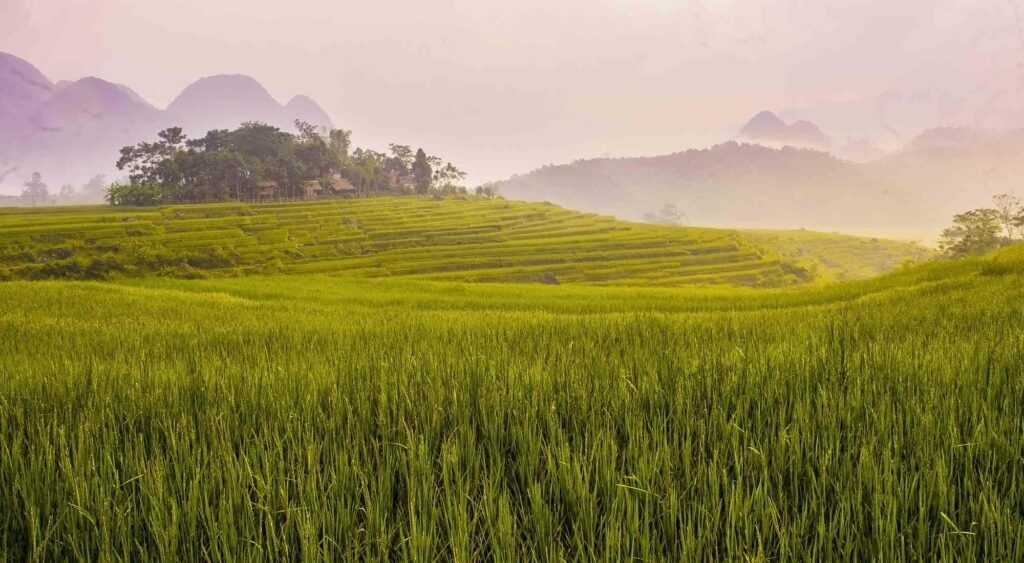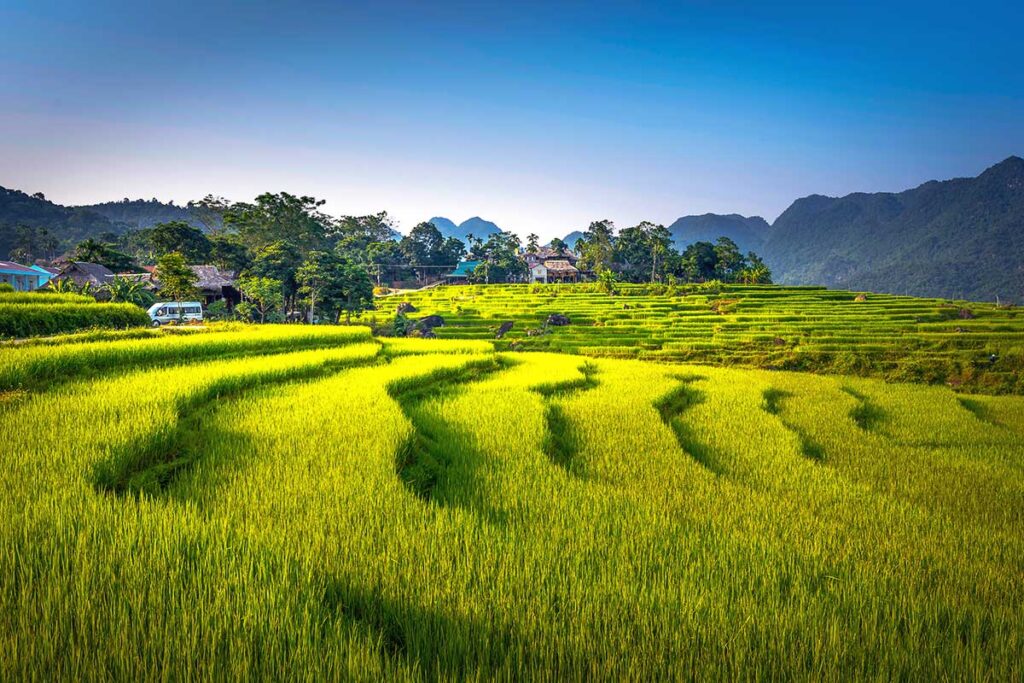Pu Luong – Hidden Valleys, Waterwheels, and Villages
Pu Luong is a protected nature reserve that stretches across Hoa Binh and Thanh Hoa provinces, running between Mai Chau and Cuc Phuong National Park. It was established in 1999 to preserve the area’s rich biodiversity and traditional way of life. Despite its beauty, Pu Luong remains relatively unknown to foreign tourists, making it a great destination for those looking to experience northern Vietnam without the crowds.
The landscape here is a mix of jungle-covered limestone mountains, bamboo forests, rivers, and stunning terraced rice fields carved into the hillsides. Scattered across the valleys are small ethnic Thai and Muong villages, where many families still live in wooden stilt houses and grow their own rice. It’s a popular place for trekking, with trails that pass through remote communities, farmland, and hidden waterfalls. Many travelers choose to visit Pu Luong as a quieter alternative to Sapa — or combine it with a trip to nearby Mai Chau.
What to see in Pu Luong
1. Mountains, jungle & waterfalls
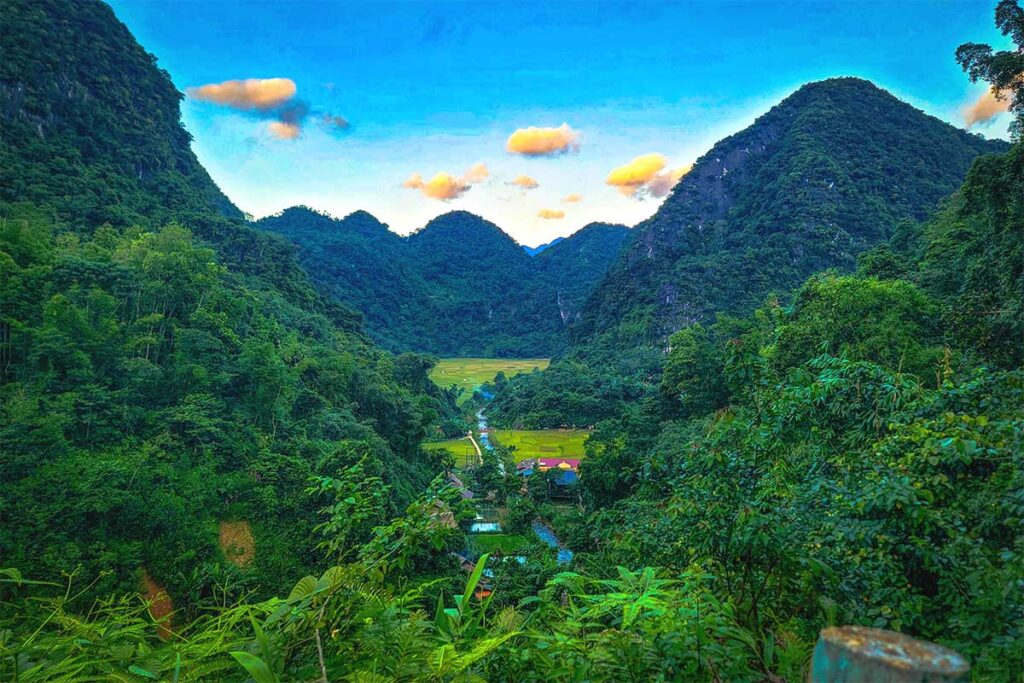
Pu Luong sits within a nature reserve that stretches across mountain ranges in Thanh Hoa Province. Unlike some other rural destinations in northern Vietnam, this area is covered not just in farmland but also dense, semi-tropical jungle. Hills rise steeply in layers, often shrouded in mist or clouds, especially in the mornings. These mountains are part of a limestone landscape, with occasional cliffs, hidden valleys, and forested ridgelines. While not as rugged as Ha Giang or as built-up as Sapa, Pu Luong offers a quieter, greener type of scenery.
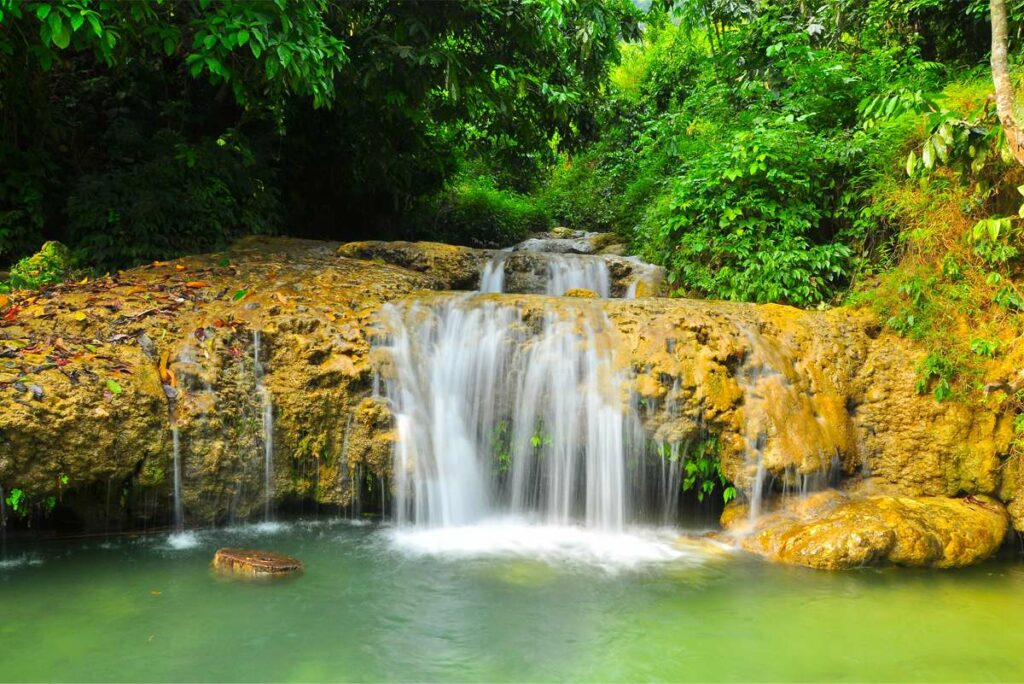
Waterfalls are scattered throughout the reserve — the most well-known being Hieu Waterfall — but others exist too, often tucked inside valleys near minority villages. Some flow year-round, while others swell during the rainy season, adding to the area’s natural feel.
2. Rice terraces

Much of the lower mountain slopes in Pu Luong have been carved into terraced rice fields by generations of Thai and Muong farmers. These terraces follow the shape of the hills and valleys, creating layered, curved patterns that change with the seasons. From May to October, they range from bright green to golden yellow, depending on the crop stage. Unlike places with only one harvest per year, Pu Luong’s terraces are cultivated twice, so the landscape transforms regularly.
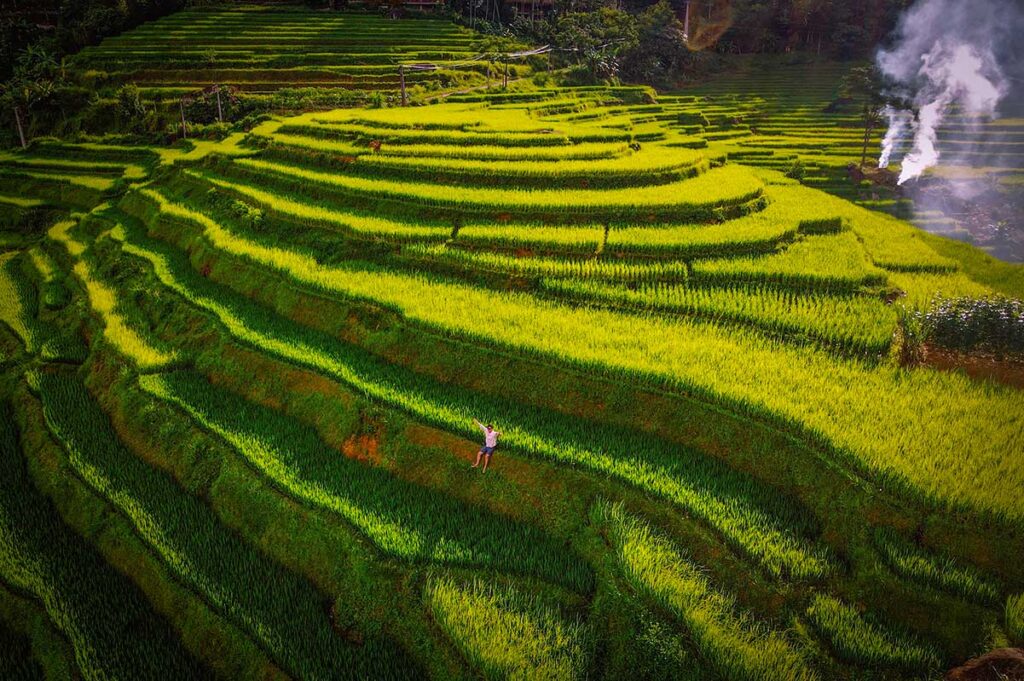
The rice fields here are often smaller and more scattered than in places like Mu Cang Chai, but they blend beautifully with the surrounding forest and stilt-house villages, giving the area its distinct rural charm.
3. Streams and water wheels
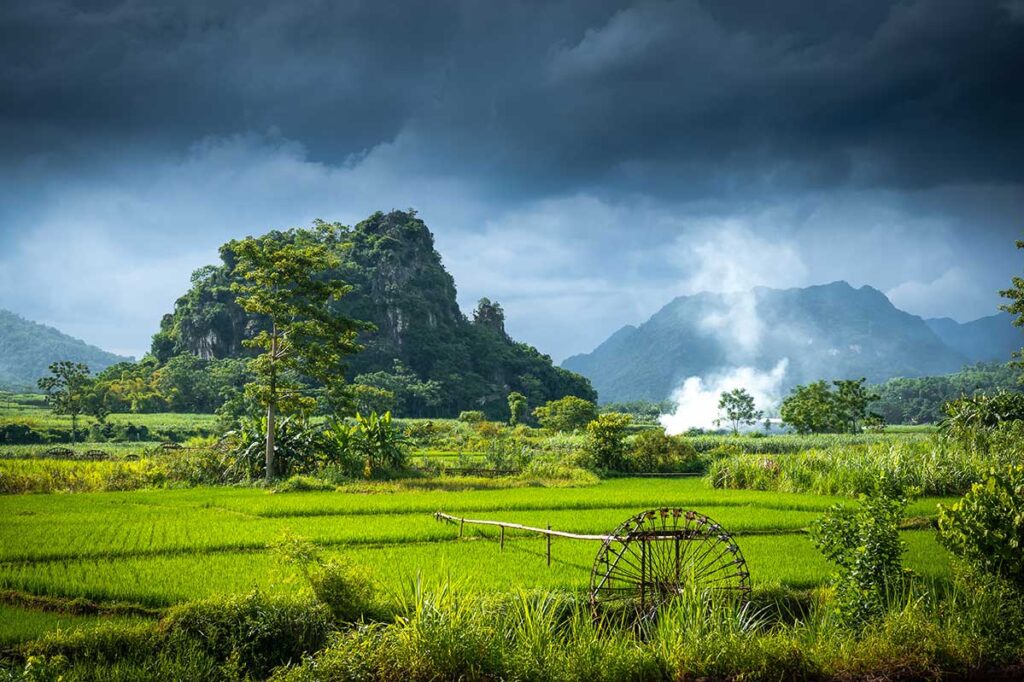
The rice terraces are fed by streams that run down from the mountains, and locals have built bamboo water wheels to lift that water into irrigation channels. These traditional devices — slowly turning in the current — are a signature of the Pu Luong landscape. The wheels scoop water into hollow bamboo tubes, which then carry it to the rice fields by gravity.

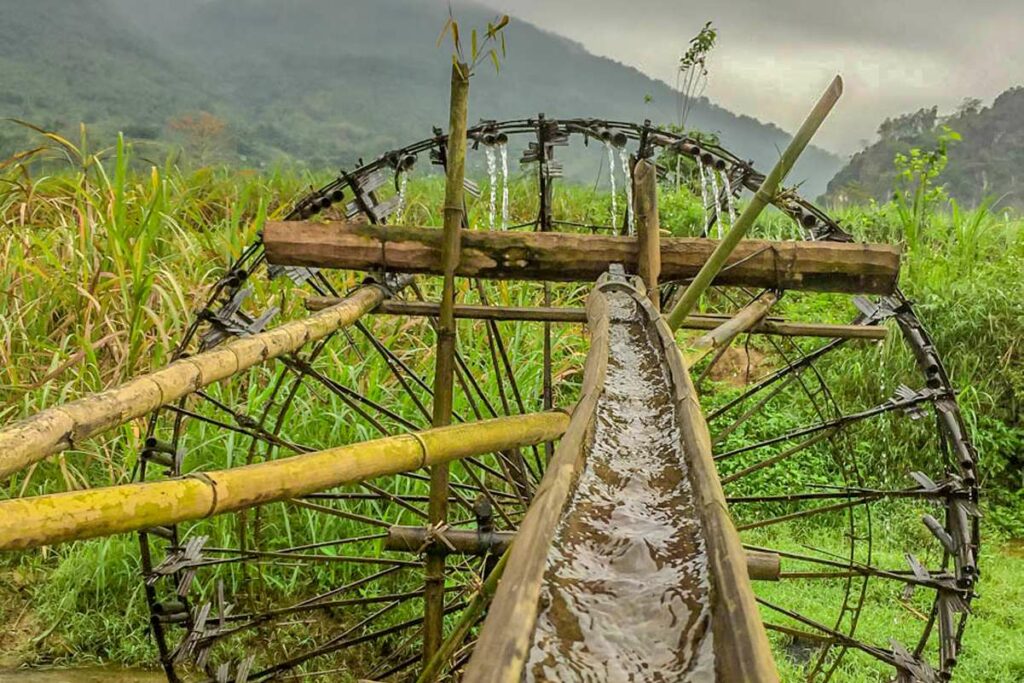
You’ll mostly see these around areas like the Cham Stream in Ban Cong commune, where multiple wheels often stand side by side along the banks. It’s a unique feature that sets Pu Luong apart from other rice-growing areas in Vietnam.
4. Villages and markets of ethnic minorities
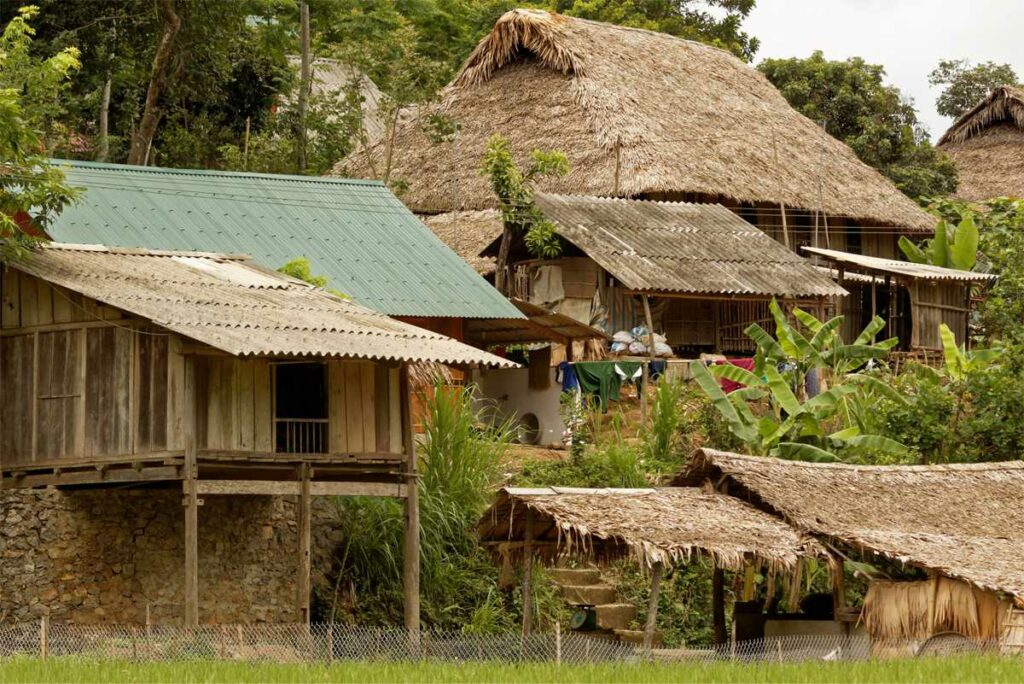
Pu Luong is home mainly to two ethnic groups: the Thai (mostly White Thai) and the Muong. These communities have lived here for generations, farming rice, raising animals, and maintaining their cultural traditions. Villages are scattered across the valleys, often located near water sources and surrounded by rice fields or forest. Homes are typically made of wood and raised on stilts, with palm leaf or tiled roofs.
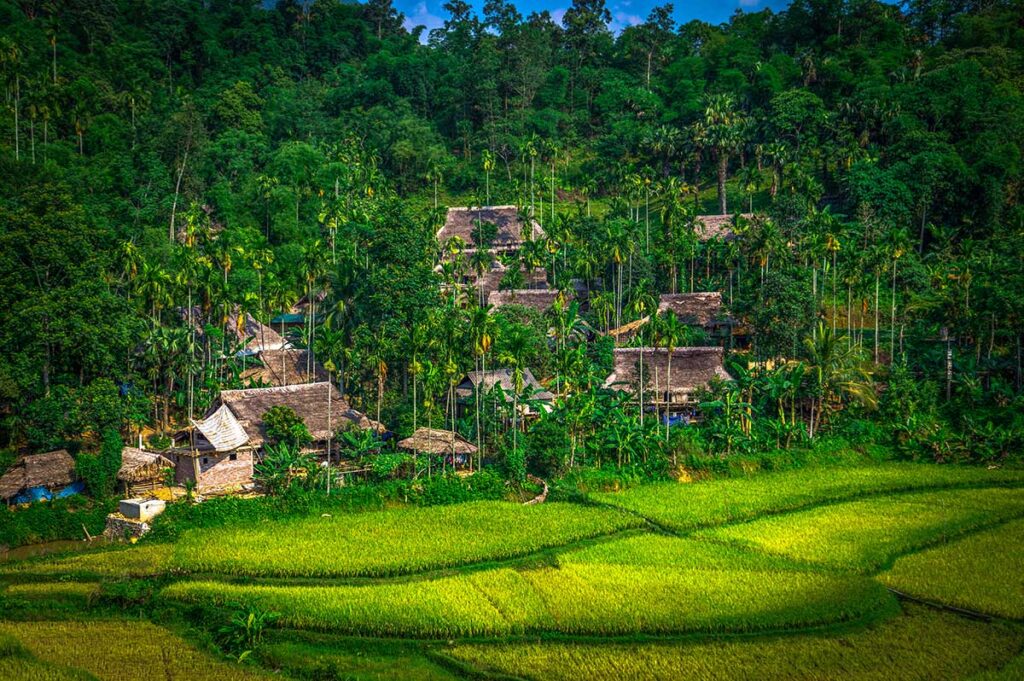
Life in these villages moves slowly. People cook over open fires, weave textiles, and farm by hand. You’ll often see women wearing traditional clothing, especially during local events or market days. Weekly markets, like the one in Pho Doan, are still the main places to buy and sell goods. Locals come early in the morning to trade vegetables, meat, tools, fabrics, and household supplies — and to catch up with neighbors over snacks and tea.
Best things to do in Pu Luong
While Pu Luong is known for its natural beauty and peaceful atmosphere, there are also plenty of rewarding activities if you know where to look. From scenic treks and bamboo rafting to hidden caves and authentic village markets, the best things to do in Pu Luong are all about experiencing local life and getting outdoors. Here are the top highlights.
1.Trekking tours in Pu Luong
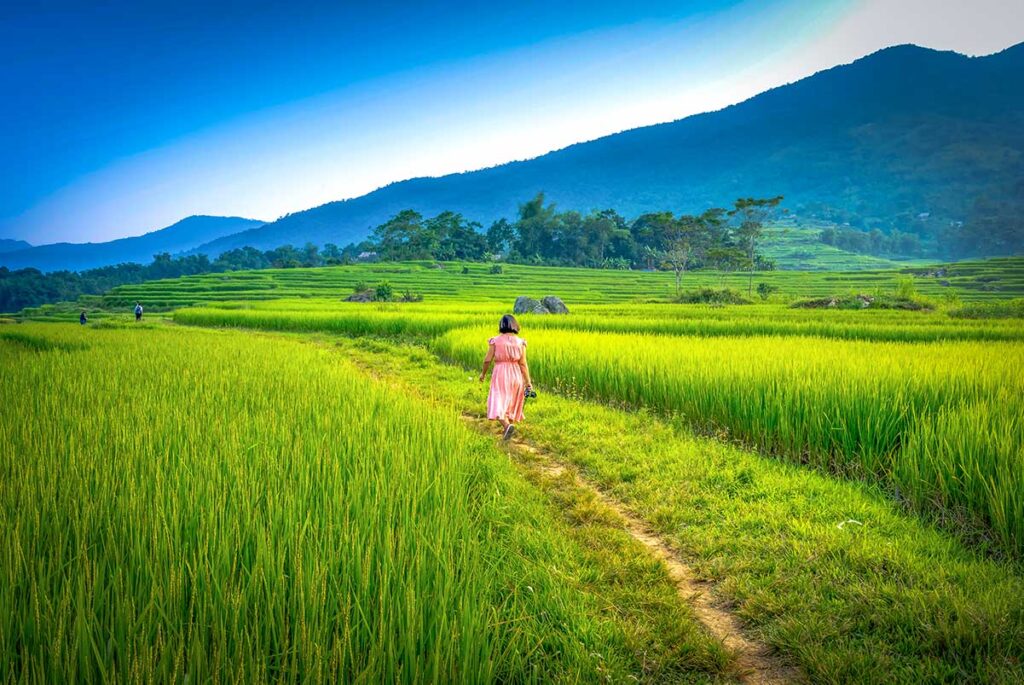
Trekking is by far one of the best things to do in Pu Luong if you want to immerse yourself in the landscape. Most treks take you through terraced rice fields, bamboo forests, and traditional Thai and Muong villages. Some are short half-day walks, others full-day adventures.
Unlike Sapa, treks here don’t typically go from one homestay to another. Instead, you hike through the countryside and finish on a road where a car picks you up. Because there are no marked trails, it’s best to book a tour with a local guide who knows the area and can explain what you’re seeing along the way.
2. Bamboo rafting on the Cham Stream
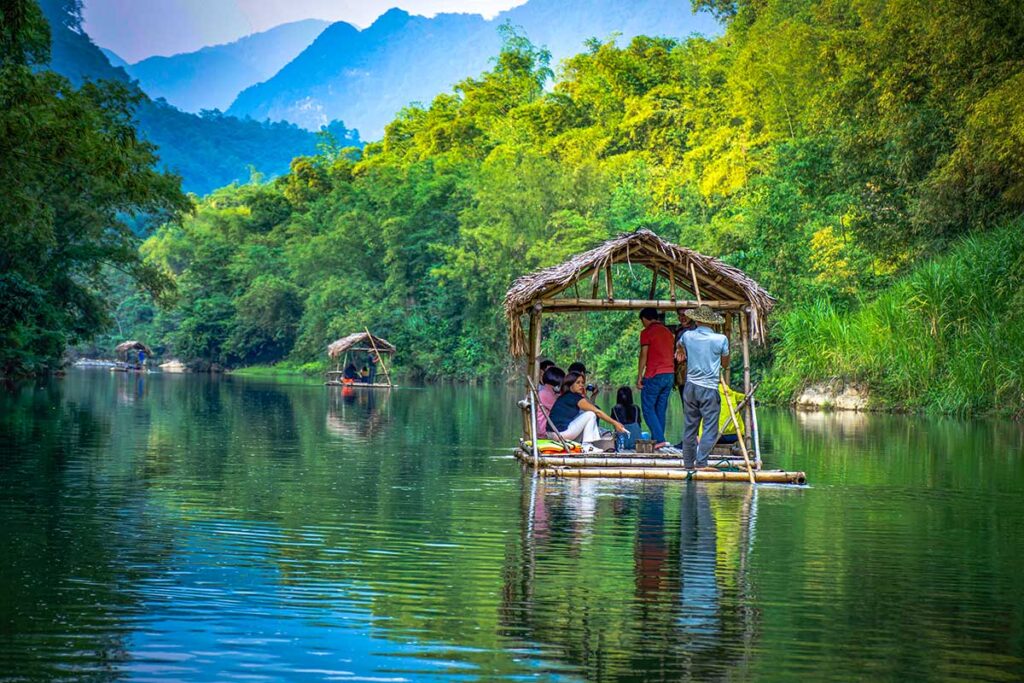
This peaceful activity gives you a unique view of local life. On a handmade bamboo raft, you float gently down the Cham Stream, passing rice fields, fishing nets, and several of Pu Luong’s iconic bamboo water wheels. The stream is calm and narrow, with jungle-covered hills rising on either side.
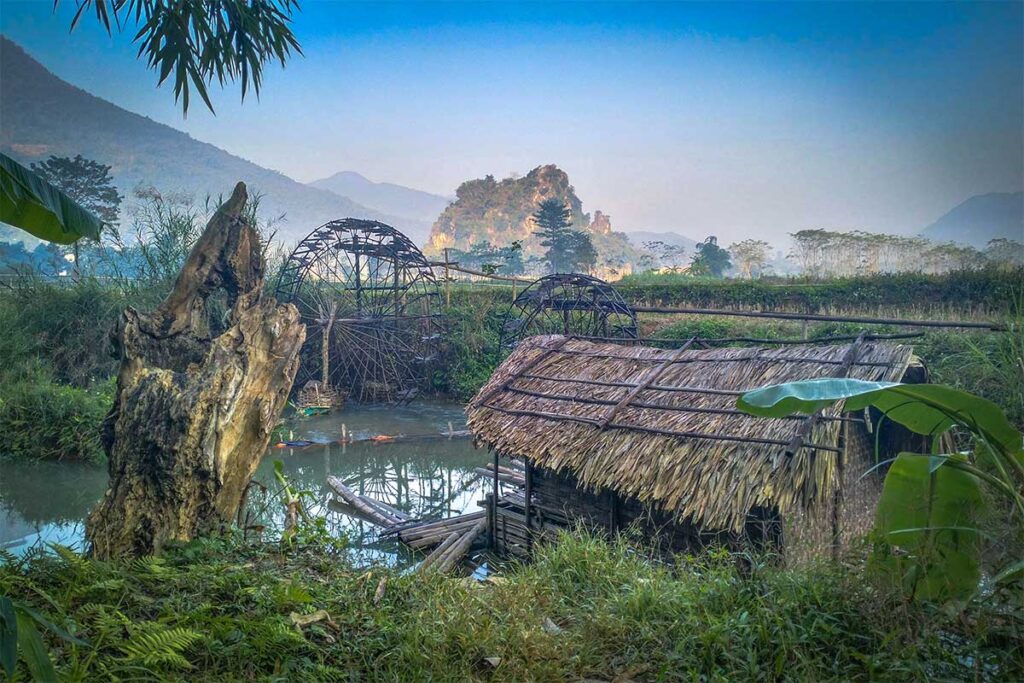
You won’t be paddling yourself — a local guide will steer the raft using a long bamboo pole. It’s a quiet, scenic experience that fits perfectly with Pu Luong’s slow rhythm of life.
Read more about bamboo rafting in Pu Luong →
3. Swimming in streams and waterfalls
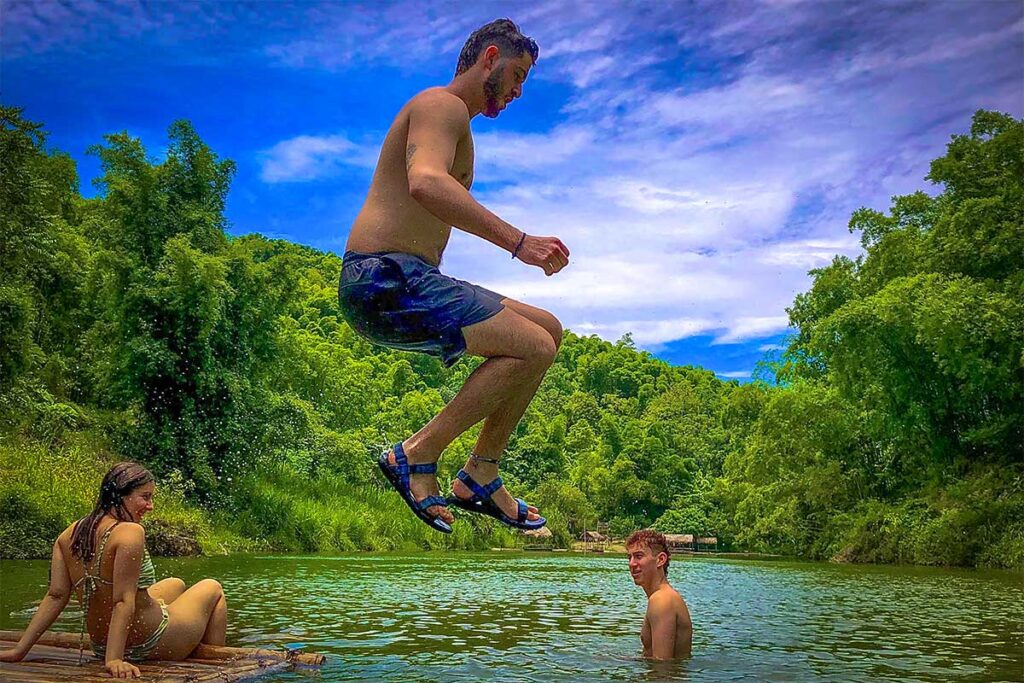
Pu Luong may not have large lakes or rivers, but it offers plenty of smaller spots to cool off. The Cham Stream has some shallow, clean sections where you can take a dip. In a few places, locals have built bamboo huts where you can rest by the water or have a meal.
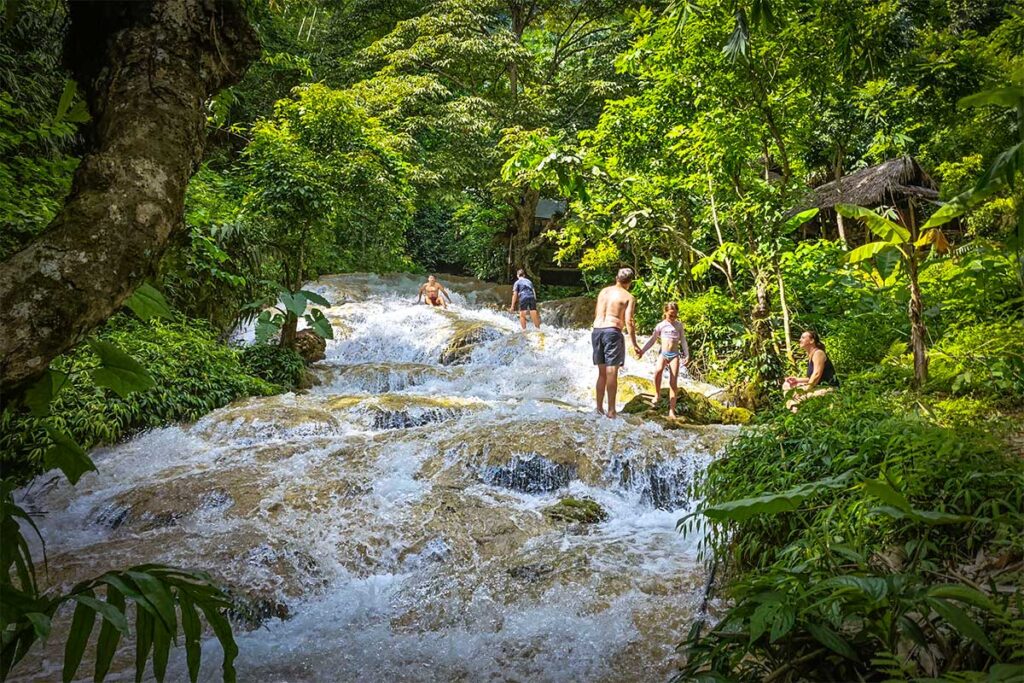
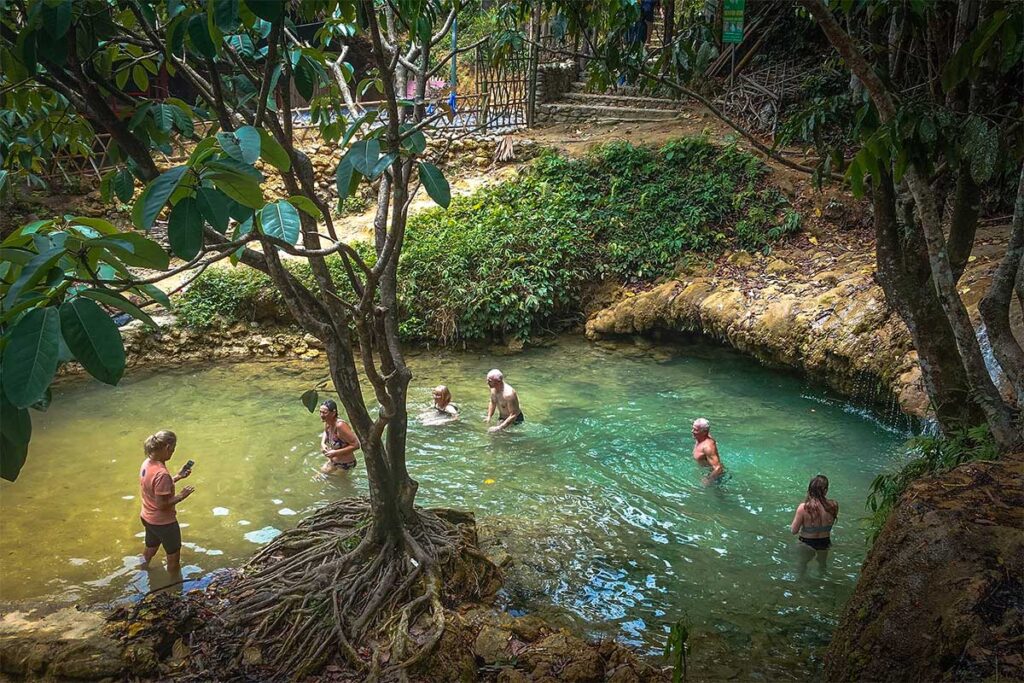
The most scenic swimming spot, however, is Hieu Waterfall. Hidden in a steep valley, the waterfall flows down in multiple steps through the jungle, creating natural pools along the way. It’s a short but steep walk from Ban Hieu village — which itself is one of the most beautiful areas in Pu Luong. You can relax, swim, or sit on the rocks while watching the water cascade through the forest.
Read more about Hieu Waterfall →
4. Exploring ethnic villages
Most of the villages in Pu Luong are home to the White Thai ethnic group, who have lived here for generations. The villages are built with traditional stilt houses, set among rice fields, bamboo groves, and forested hills.
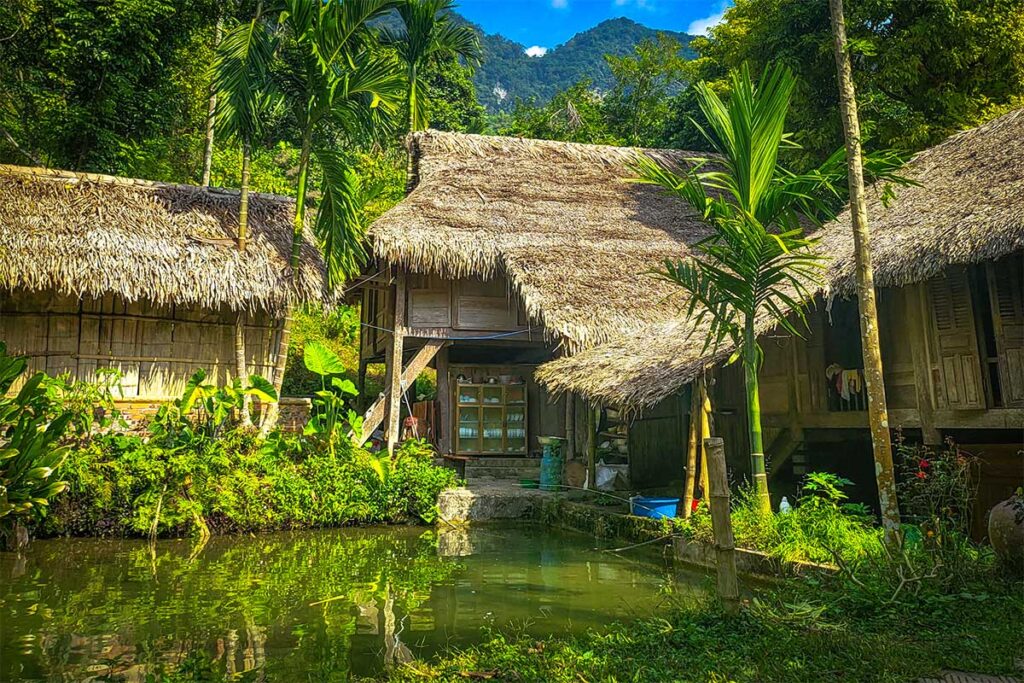
Visiting these villages is not about seeing staged performances or souvenir shops — it’s about observing everyday life. You’ll see people planting rice, weaving fabric, drying herbs, or simply sitting outside with their families.
If you go with a local guide, they can often help you connect more directly with people. While there are no formal workshops, a guide can help you to connect with villagers to try something hands-on — like dyeing fabric, weaving on a loom, or even riding a buffalo. These interactions depend on the moment, and that’s what makes them feel genuine.
5. Discover Bat Cave
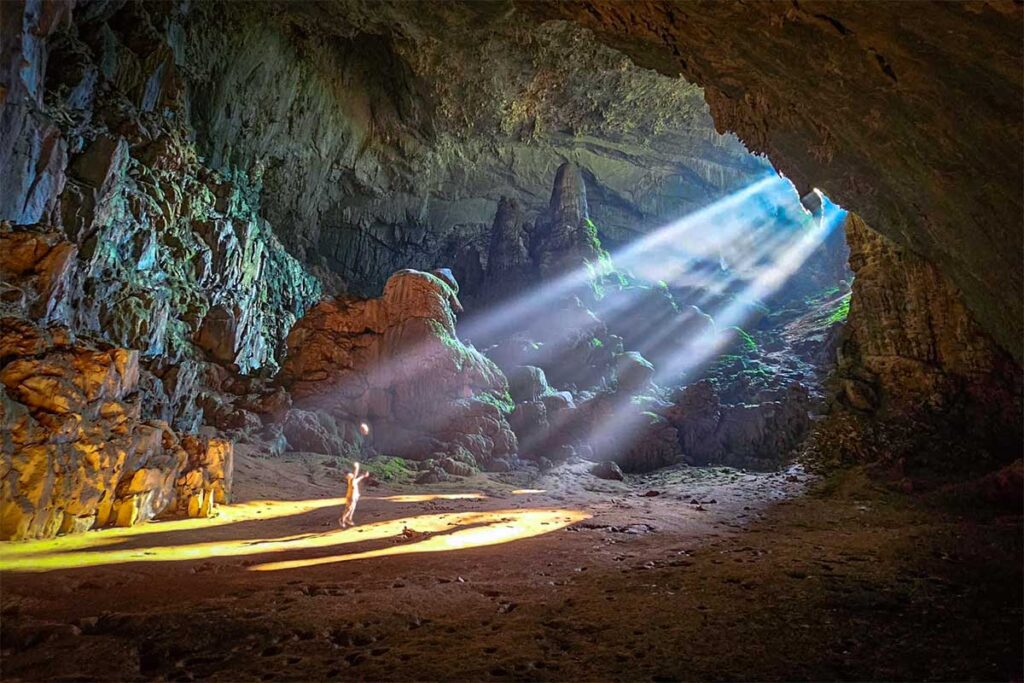
Doi Cave — more commonly known as Bat Cave — is one of the largest caves in Pu Luong. It’s located near Kho Muong village and home to thousands of bats across several species. While the cave itself is modest compared to places like Phong Nha, it’s still impressive to see inside.
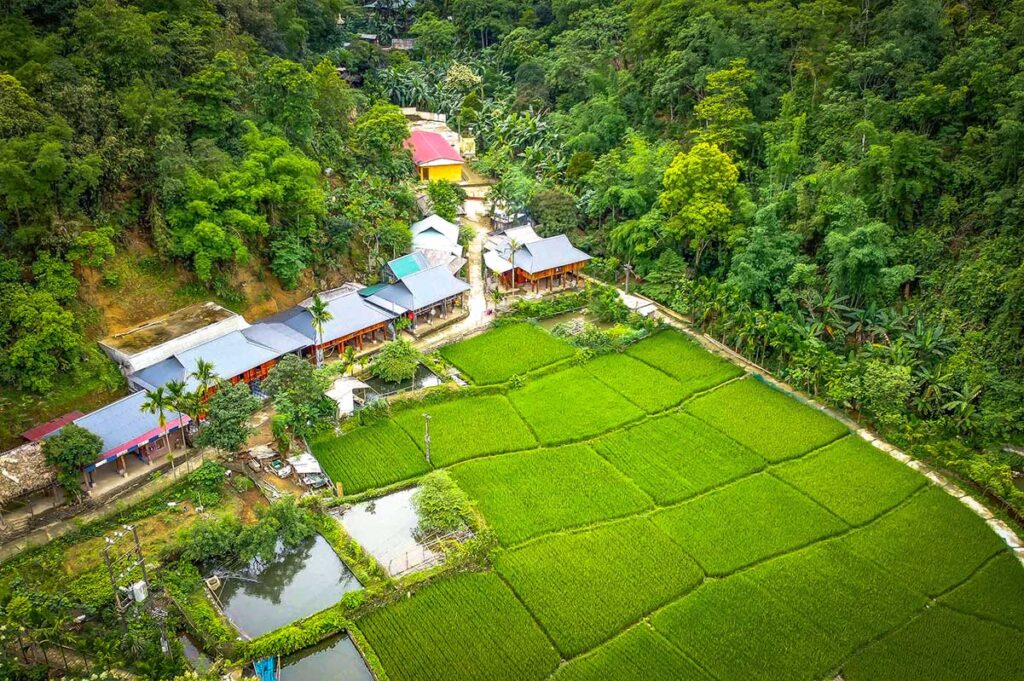
That said, the real highlight is the journey to get there. You’ll pass through a peaceful valley with terraced fields, jungle-clad hills, and a remote ethnic village where life has barely changed. For many travelers, this is just as memorable as the cave itself.
Read more about Bat Cave (Kho Muong) →
6. Visit the Pho Doan Market
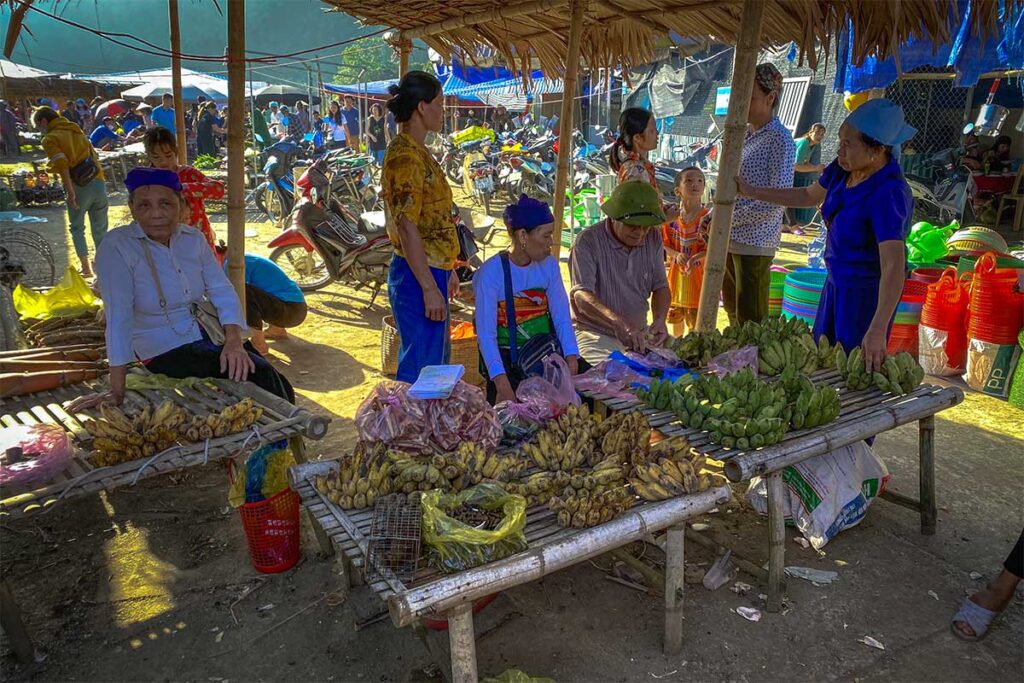
If you’re in Pu Luong on a Thursday or Sunday, visiting the Pho Doan Market is a must. It’s one of the few places where people from surrounding villages gather in large numbers, wearing traditional clothing and selling everything from vegetables to handwoven fabrics.
The market is busiest early in the morning and gives you a great chance to see ethnic culture in action — not a staged show, but part of real life.
Read more about Pho Doan Market →
7. Cycling around the valley
Cycling may not be the most common activity in Pu Luong, but it’s definitely one of the most enjoyable if you know the right route. Some parts of the nature reserve are quite hilly and best avoided unless you’re very fit. Others are more gentle and allow you to cruise past rice fields, villages, and viewpoints.
Most lodges and homestays don’t rent bikes directly, so cycling is usually arranged as part of a guided tour. This not only helps with logistics, but also means you’ll take routes with beautiful scenery and safe downhill stretches.
8. Enjoy unique accommodations
In Pu Luong, where you stay is often part of the adventure — which is why this deserves a place among the top things to do in Pu Luong. Whether you’re into rustic or refined, there are two standout options:
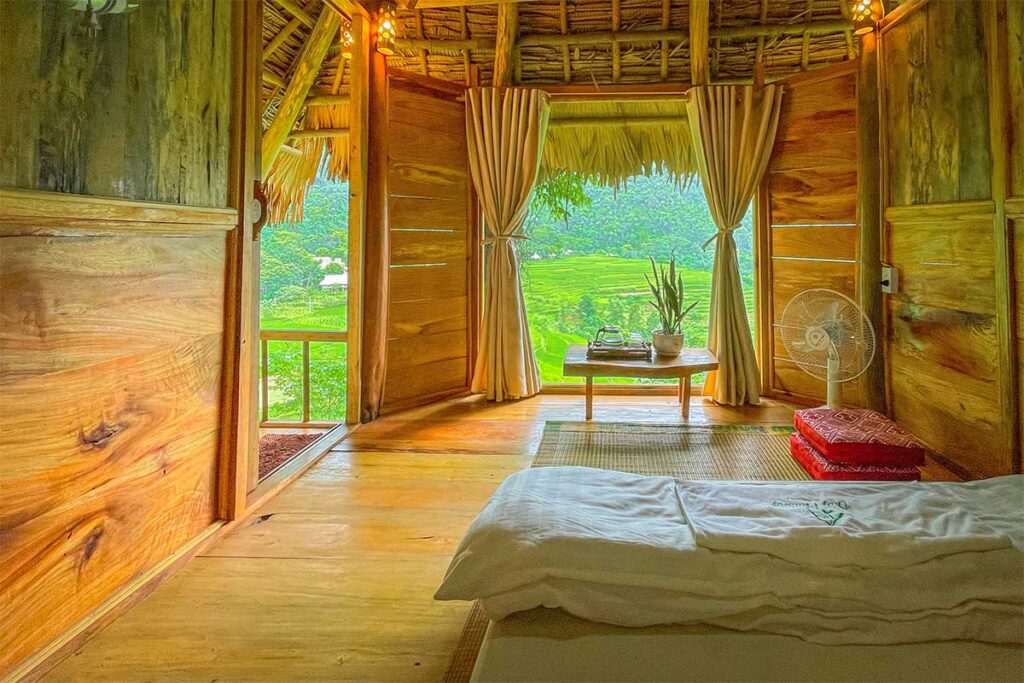
Traditional ethnic homestays: Staying with a Thai family in a stilt house gives you an authentic, local experience. You’ll sleep on a simple mattress under a mosquito net, eat home-cooked meals, and wake up to the sounds of roosters and running streams.
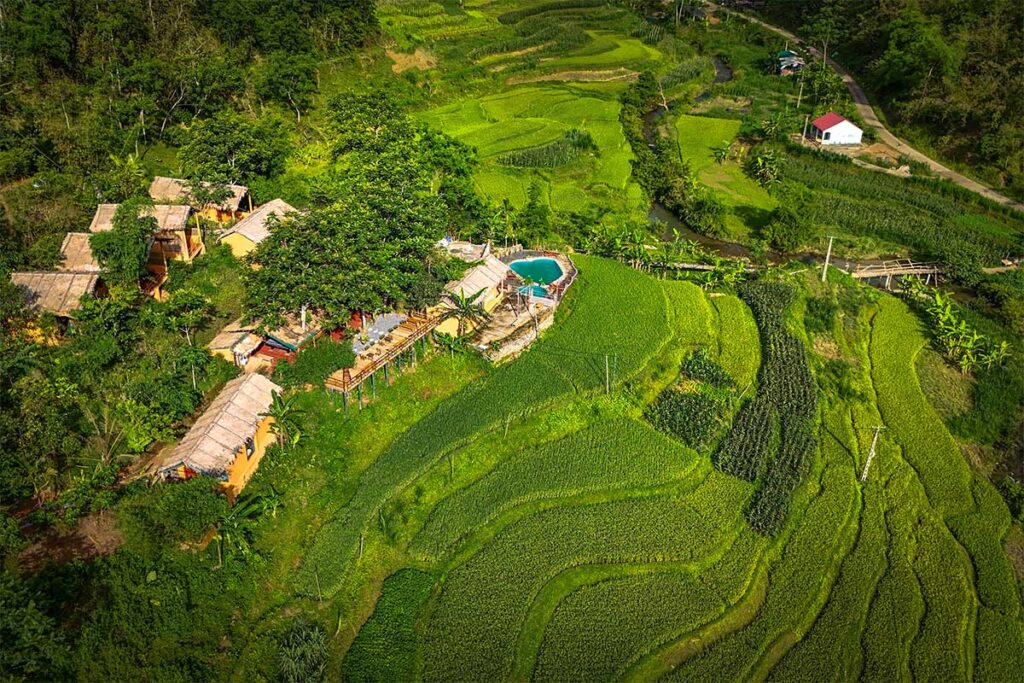
Luxury lodges: If you’re looking for comfort without losing the view, Pu Luong has some excellent eco-lodges and retreats. Many have infinity pools overlooking the rice terraces and jungle — perfect for relaxing after a day of trekking or exploring.
Best time to visit Pu Luong
The best time to visit Pu Luong depends on what you want to see — golden rice terraces, lush green fields, or dry and pleasant trekking weather.
There are two rice seasons in Pu Luong:
– February to May for vibrant green paddies and the first harvest
– July to October for another round of greenery followed by golden rice landscapes during the main harvest season

For scenery, late September to early October is the most iconic time to see golden rice fields. For a greener and quieter experience with ideal hiking conditions, March and April are excellent months. These months fall during the dry season (October to April), when the weather is mild and paths are easier for trekking.
The rainy season (May to September) brings heavier showers and hotter days, but also lush landscapes, stronger waterfalls, and fewer visitors. It’s not the best for hiking but can be a great time for photography or relaxing in nature.
See our full breakdown of rice seasons and monthly weather in Pu Luong →
How to get to Pu Luong Nature Reserve
Pu Luong is about 150 km from Hanoi and takes roughly 4.5 hours to reach. While it’s still off the main tourist trail, getting there has become easier with better transport options.
Join a tour to Pu Luong
If you don’t have much time or simply want a hassle-free experience, joining a tour is the easiest option. A typical Pu Luong tour includes transport, accommodation in a homestay or lodge, meals, and short guided treks. Tours are usually private or in small groups, which suits the peaceful nature of the reserve.
Tip: You can also combine Pu Luong tours with nearby highlights like Ninh Binh and Mai Chau.
Travel by yourself from Hanoi
Limousine van from Hanoi
This is now one of the most convenient ways to reach Pu Luong. Several companies run direct limousine vans (9–16 seaters) from Hanoi, often including hotel pickup in the Old Quarter and drop-off at your accommodation in Pu Luong.
- Duration: ~4.5 hours
- Price: Around 350,000 VND (approx. $14–15 USD)
- Comfort: Very high — spacious seats, air-con, often with Wi-Fi.
You can book these vans online (vexere) or via your accommodation in advance.
Private car from Hanoi
A private car offers the most flexibility. You can travel directly to Pu Luong, stop at Mai Chau along the way, or combine it with other destinations like Ninh Binh.
- Price: From around $110 USD one way
- Multi-day option: You can also hire the car to stay with you for a broader trip through Pu Luong or the region, especially useful if you don’t trek or prefer private sightseeing.
Driving a motorbike
If you’re an experienced rider, you can also reach Pu Luong by motorbike. However, this is only recommended for those confident with mountain roads. The route includes hilly and remote sections.
- Tip: It’s best to break the ride with an overnight stay in Mai Chau.
- Note: Pu Luong is not ideal for beginners or casual riders due to the terrain.
From Mai Chau to Pu Luong
Day Trip from Mai Chau
Staying in Mai Chau? A day trip to Pu Luong is very doable. It’s about 1.5 hours by car or motorbike, and many travelers combine the two destinations.
Join our Day Trip from Mai Chau to Pu Luong
This is ideal if you want to see highlights like the water wheels, rice terraces, or villages — without changing accommodation.
Rent a scooter
You can also rent a motorbike or scooter in Mai Chau to explore Pu Luong independently. This gives you the flexibility to stop along the way and take in the rural scenery. Just be mindful of steep mountain sections and make sure your rental bike is in good condition.
How to get around Pu Luong
Getting around Pu Luong isn’t as straightforward as in touristy areas, but with a bit of planning, it’s part of the adventure.
Trekking
Trekking is the best way to explore Pu Luong’s landscape — whether it’s forest trails, rice terraces, or remote villages. Some smaller roads appear on Google Maps, but don’t rely on it too much. Local guides know the most scenic routes, unmarked paths, and can help arrange transport back to your accommodation from the end of a hike.
Scooter or Motorbike
There are no official rental shops in Pu Luong. Some homestays rent out their own scooters, but quality varies — always check brakes and lights. Most larger eco-lodges don’t offer rentals themselves, so you’ll need to check with local families nearby. If you’re coming from Mai Chau, you can rent a bike there and bring it into Pu Luong. But be warned: many roads in Pu Luong are steep, narrow, and not ideal for beginners.
Cars and Transfers
Taxis don’t operate inside Pu Luong, and private cars aren’t readily available. Most travelers arrange transport from Hanoi or Mai Chau in advance. Some lodges run shuttle services to nearby highlights like Pho Doan Market or Hieu Waterfall. If you don’t ride a motorbike, many homestays can organize a motorbike taxi for short trips.
Where to stay in Pu Luong Nature Reserve
A narrow road cuts through the reserve along the valley and connects a series of small villages and hamlets. In recent times, there have been more accommodations being built in Pu Luong. However, due to tight government regulations, there are no big resorts or hotels, and only a small area is allowed for development. This allows it to stay tranquil and not overdeveloped.
Eco-lodge and resorts
Most of the resorts and lodges in Pu Luong blend seamlessly into the landscape, often having a pool and rooms overlooking the rice fields. Some of the most popular choices are:
Puluong Retreat
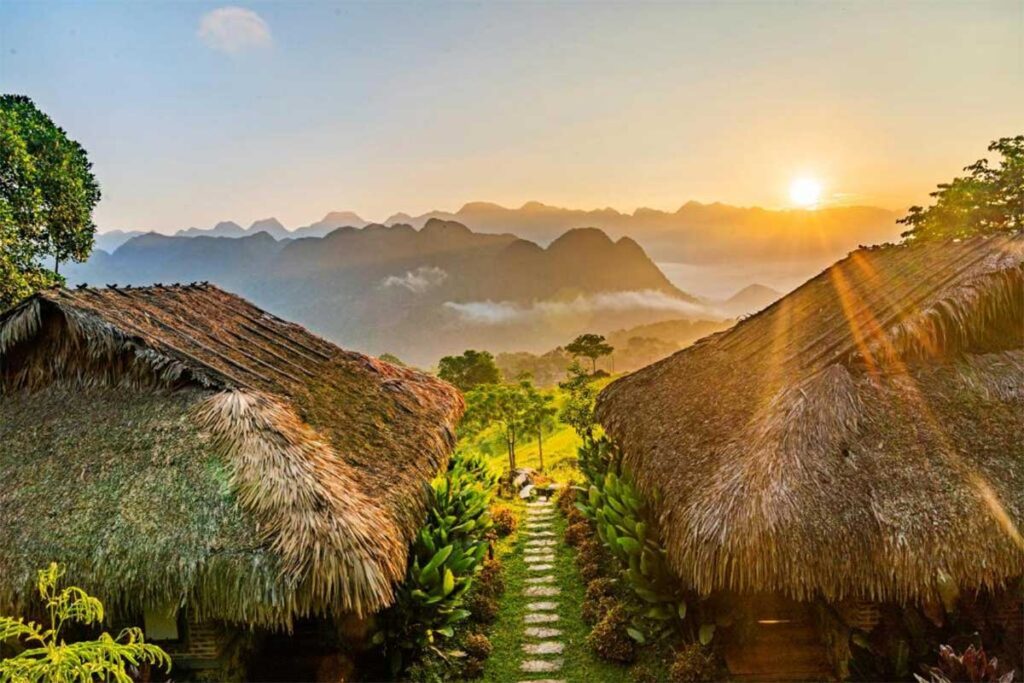
Puluong Retreat offers a serene escape with its rustic charm and stunning views of terraced rice fields. The retreat features a mix of traditional stilt houses and modern bungalows, all designed to blend harmoniously with the natural surroundings. Guests can enjoy an infinity pool overlooking the valley, as well as various activities such as trekking, cycling, and cultural tours.
Pu Luong Eco Garden
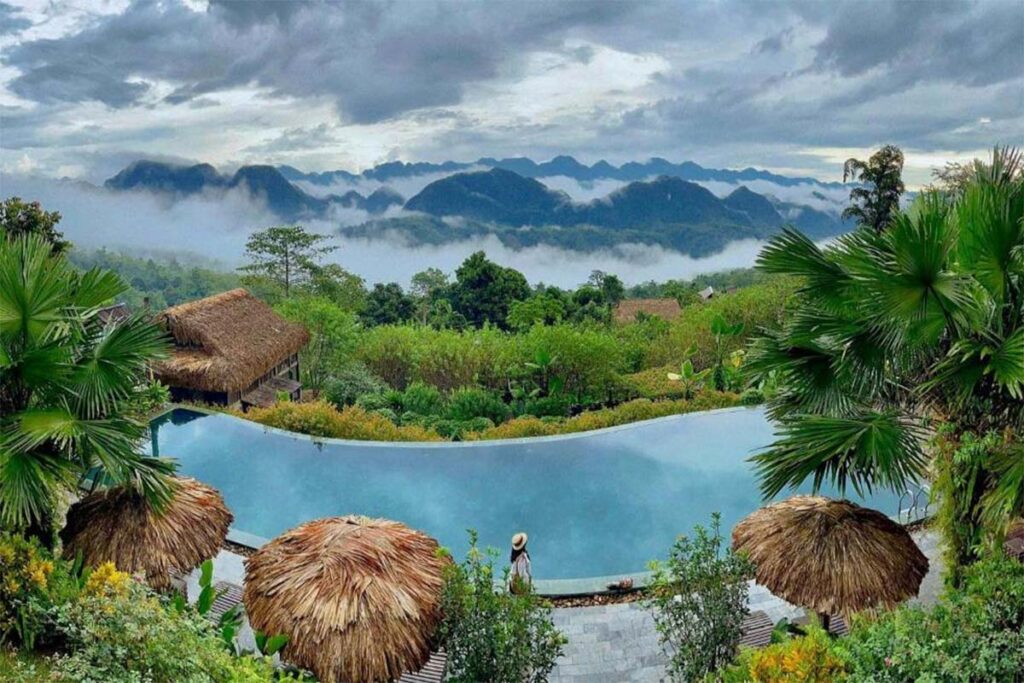
Pu Luong Eco Garden is known for its peaceful ambiance and eco-friendly design. The resort boasts beautiful bamboo bungalows and a spacious garden area. Visitors can relax by the pool with panoramic views of the rice terraces or participate in guided hikes and community-based tourism activities. The eco garden emphasizes sustainability and local cultural experiences.
Puluong Casa Resort
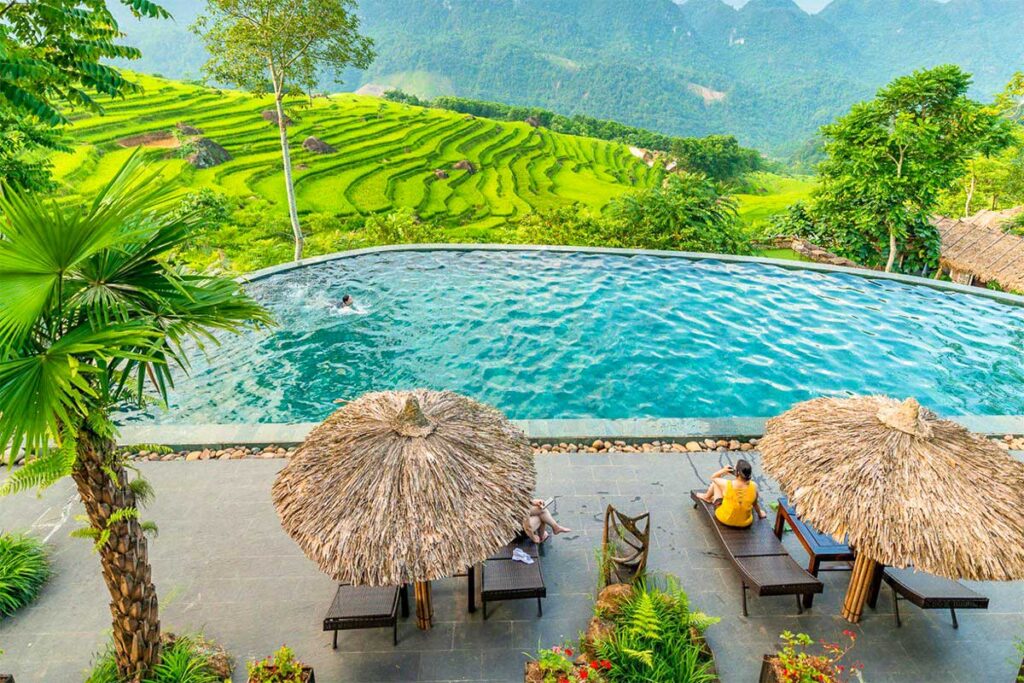
Puluong Casa Resort combines comfort with a rustic touch, offering spacious rooms with private balconies that provide breathtaking views of the lush green landscape. The resort includes a lovely outdoor pool and an on-site restaurant serving local and international cuisine. Its location makes it a perfect base for exploring the natural beauty of Pu Luong.
Puluong Luna Resort
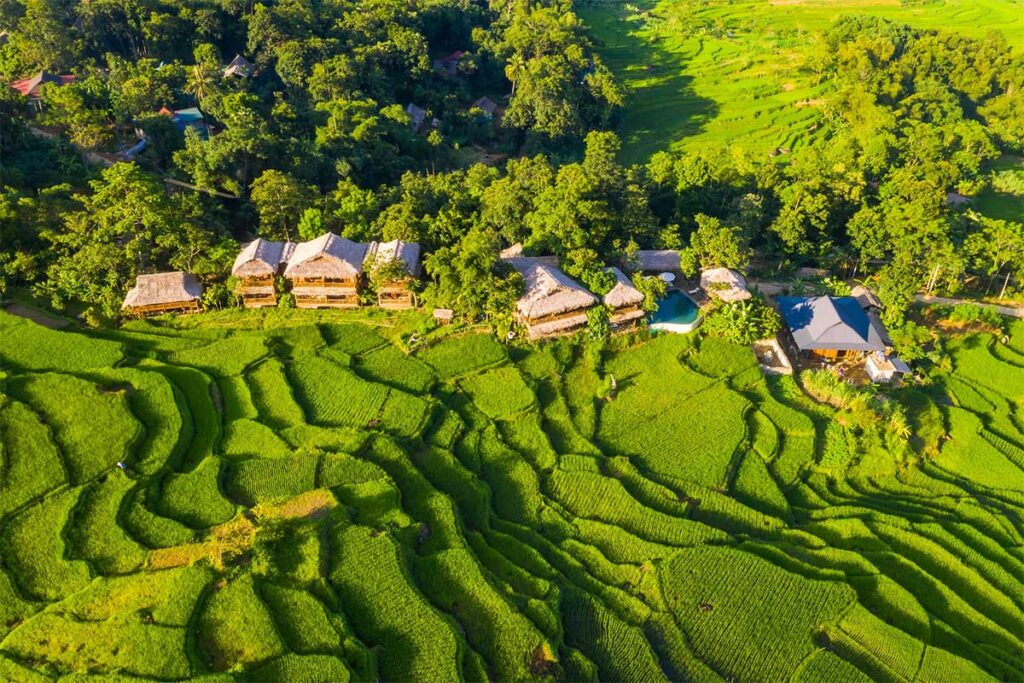
Puluong Luna Resort is nestled in a picturesque setting, offering a blend of traditional architecture and modern comfort. The resort features an outdoor pool with a view of the valley, cozy bungalows, and an open-air restaurant. It’s an ideal spot for those looking to unwind and experience the natural beauty and tranquility of Pu Luong.
Homestay in Pu Luong
For a more authentic experience, you can stay with ethnic people in Pu Luong, who often live in traditional stilt houses. These homestays offer a unique cultural immersion, allowing you to experience the local way of life. Some of these homestays can be found on popular booking sites, but others, operated by locals with limited internet knowledge, can only be booked by showing up in person. Staying with an ethnic family not only supports the local community but also provides an enriching cultural exchange that is often a highlight of the trip.
In these typical homestays, the rates for sleeping at night are incredibly cheap: between 50,000-100,000vnd ($ 2- $ 4) per night. This is because the sleeping places are simple: usually a mattress on a wooden floor under a mosquito net in a common dormitory on the first floor of a stilt house, often with curtains or partitions for privacy, and a shared bathroom. (Read more about: what is a homestay?)
Villages and areas
Ban Hieu: A small but scattered collection of thatched bamboo houses on stilts, built on a steep mountain slope. There is a collection of at least five homestays, each a little further up the mountain slope than the previous one. The village can only be reached on foot or by motorbike.
Kho Muong: A spectacular location with extraordinary views. The most famous accommodation is Pu Luong Retreat. This is a luxury boutique-style resort with an infinity pool. Further down the hill you will find Pu Luong Treehouse and Nature Lodge.
Ban Hang: You come here via a steep dirt road that leads from the main road QL15C through Pu Luong. Here you will find a cluster of homestays. These homestays are popular with young Vietnamese travelers and some travel groups. Because the location is low (in the valley), the views are not as spectacular as other homestay areas.
Lung Cao / Ban Nua: In the middle of the nature reserve. Ban Nua Homestay is generally very nice but simple. Some of the host families are accessible via the asphalted road along the valley, but others need a good motorbike, 4 × 4 or going on foot.
Eating & restaurants
Because Pu Luong Nature Reserve has no towns or large villages, and because most homestays are located in relatively remote hamlets in the countryside, there are almost no shops, food stalls or restaurants. Instead, the host families cook delicious meals for their guests. It is still a good idea to bring some snacks for in between meals. The price of sleeping in a host family does not include food. Because sleeping places are usually simple, the cost of meals is often two or three times as much as when sleeping. Prices range from just 30,000-70,000vnd per person for breakfast, to 100,000-250,000vnd per person for dinner. So expect to pay around 200,000-250,000vnd per person for half board.
For staying in eco-resorts the same applies, you will mostly eat in in the resort. During a day tour you eat at a local house or sometimes lunch is prepared.
What to bring to Pu Luong
Pu Luong is remote and rural, with very few shops or convenience stores. You won’t find places to buy essentials once you arrive, so it’s best to come prepared — especially if you’re staying in a homestay or planning outdoor activities.
Essentials
- Sunscreen – The sun can be strong during treks and outdoor activities.
- Mosquito repellent – Especially important in the evenings or if you’re near streams.
- Reusable water bottle – Many lodges offer free refills; helps reduce plastic waste.
- Basic medicine – Bring your own painkillers, stomach medicine, or allergy tablets, as there are no pharmacies nearby.
Get cash in Hanoi
There are no ATMs in Pu Luong.
If you’re staying in a lodge, card payment is usually possible. But for homestays, market visits, bamboo rafting, or tipping local guides, cash is essential — and smaller bills are helpful.
For trekking and exploring
- Comfortable walking shoes – You don’t need heavy hiking boots, but good grip is important.
- Daypack – Useful for carrying water, snacks, and gear on hikes.
- Light rain jacket or poncho – Sudden showers can happen, especially in the rainy season.
- Flashlight or headlamp – Useful in rural areas or if staying in a homestay without full lighting.
Weather-related clothing
- Warm layers (Nov–Feb) – Mornings and nights can be cold, especially in winter.
- Quick-dry clothes (May–Sept) – It’s hot and humid during the rainy season.
- Swimwear – Great for cooling off in streams or waterfalls.
- Hat and sunglasses – Especially useful during dry, sunny months.
Pu Luong or Sapa?
What is better in Sapa
- Easier to reach: Sapa is more accessible with a highway and train connections.
- More activities: Sapa offers a larger area with more activities, including ethnic markets and the opportunity to take a cable car up Fansipan Mountain.
- Accommodation and dining: There are numerous options for accommodations and restaurants, catering to a variety of budgets and preferences.
- Larger rice terraces: The rice terraces in Sapa are more extensive.
What is better in Pu Luong
- Off the beaten path: Pu Luong is more relaxed and less touristy, offering a serene and off-the-beaten-track experience.
- Diverse scenery: The landscape includes not only rice terraces but also jungles, creating a more diverse and lush environment.
- Two harvest seasons: Pu Luong has two harvest seasons a year, unlike Sapa’s single season. Visiting in spring means you can see beautiful rice fields in Pu Luong while Sapa’s fields are still bare.
Conclusion
If you prefer a more off-the-beaten-track and tranquil experience without many tourists, opt for Pu Luong. If you prefer an easier visit with more options for getting there, things to do, and places to stay, choose Sapa.
